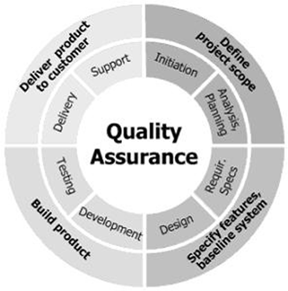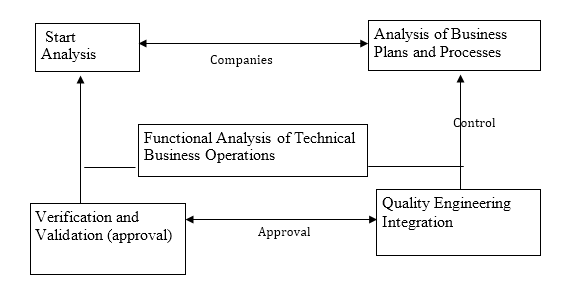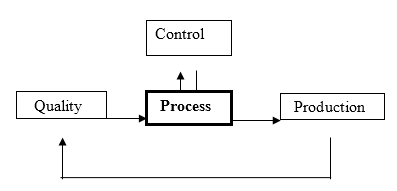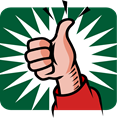Proceeding Article
Volume 1 Issue 2 - 2017
Effective Processes For Quality Assurance
Boyd Lambert Summers*
BL.Summers, Consulting, LLC Software and Quality Assurance Solutions 7291 W. Sonoma Way Florence, Arizona
*Corresponding Author: BL.Summers, Consulting, LLC Software and Quality Assurance Solutions 7291 W. Sonoma Way Florence, Arizona.
Received: February 08, 2017; Published: April 04, 2017

CONTENTS
Preface
Acknowledgements
Summary
List of Figures
List of Tables
Chapter 1
Introduction
1.1 Quality Assurance …………………………………………………………........62
1.2 Vision .……………………………………………………………………….…….62
1.3 Mission …………………………………………………………………………... 62
1.4 Quality Planning …………………..……………………………………….........62
1.5 Perform Audit and Evaluations ……………………………………….............63
1.6 Record and Report Audit and Evaluation Results ………………...............63
1.7 Quality Management ………………………………………………………......64
1.8 Policy………………………………………………………………………….....64
1.9. Quality Engineering ……………………………………………………….....64
Chapter 2 ………………………………………………………………………….65
Quality Assurance Drives Quality Production …………………………...65
2.1 Introduction ……………………………………………………….……….…..65
2.2 Lean and Agile ………………………………………………………………..65
2.3 Pro-Active Approach to Quality Assurance ……………………............…66
2.4 Quality Assurance is First ………………………………………………......66
2.5 High Performance Work Teams ………………………………………..…..67
2.6 Plan Implementation …………………………………………………….......67
2.7 Tasks and Results …………………………………………………….…....67
2.8 Quality Management System ………………………………………….....68
2.9 Customer Satisfaction …………………………………………………....68
Chapter 3………………………………………………………………......….70
Quality Assurance Methods ……………………………………………...70
3.1 Introduction …………………………………………………………….....70
3.2 Quality Assurance Methods ………..………………………………..….70
3.3. Functional Quality Assurance Tasks ……………………………..….70
3.4. Perform Effective Process Evaluations …………………………..….70
List of Figures
Figure 1.1 Quality is Important ……………………………….… 62
Figure 1.2 Electronic or Documents……………………........….63
Figure 1.3 Flow of Quality Engineering…………..………….…65
Figure 2.1 Agile Management Model ………………………....66
Figure 2.2 Process Improvements ………………………….…69
List of Tables
Table 2.1 Quality Assurance Activities ……………………………...…66
Table 2.2 Peer Review Method ……………………………………..…68
Preface
For years I have always wanted to write a book related to Quality Assurance. The new book is titled; Effective Processes for Quality Assurance. Quality Assurance processes, activities and plans ensure business and program contract implementation is an accomplishment for Quality Assurance to be implemented in companies, institutions, military programs, and successful businesses. My previous books; Software Engineering Reviews and Audits and Effective Methods for Software and Systems Integration provided the framework and detailed requirements for Quality Assurance.
Software Engineering Reviews and Audits - Contents:
Software Engineering Reviews and Audits will improve individual and company efforts in maintaining a professional setting where Quality is developed for profit, cost reduction, control, and service improvement. Performing reviews and audits for Quality Assurance are successful to ensure compliance in specified contracts and customer satisfaction for successful companies and institutions.
Effective Methods for Software and Systems Integration - Contents:
In order to develop, operate, and maintain software and systems integration capabilities inside work product facilities and companies, there must be a major discipline in supporting the entire software life-cycle (i.e., planning, systems, requirements, design, builds, installations, integration, subcontractors, quality, and delivery to customers) be complete and understood.
Acknowledgments
I want to thank my lovely and beautiful wife of 41 years; Jana for her support while writing all my past written books. Jana provides great input as well. The opportunity to be a contributor and consultant for businesses and a team player inside companies and institution environments has been something that has provided expertise.
Currently I am a Software and Quality Assurance Technology consultant supporting Quality Assurance activities and providing quality expertise and solutions for Quality Assurance and Control.
To ask questions for current and future Quality Assurance solutions my email is provided below:
bl.summers.consulting.llc@gmail.com; All important information related to this topic will be provided.
Boyd Lambert Summers
Florence, Arizona USA
Summary
It is critical to understand and implement the disciplines for Quality Assurance prior to deliveries of important and quality products inside and outside company and institution environments. Chapters in this book are documented to ensure inside or outside Quality Assurance auditors are trained and chartered to partner with companies and/or institutions and instill quality and product requirement compliance thru in-house audits and evaluations and to provide effective oversight.
About the Author
Boyd L. Summers is currently a retired Software Engineer – Quality for The Boeing Company and is a Software Technology Consultant for BL.Summers.Consulting.LLC in Florence, Arizona. Boyd is an author of the two software technology books titled; “Software Engineering Reviews and Audits” and “Effective Methods for Software and Systems Integration”. Boyd provides written Software Articles to Software Engineering Journals and magazines. Topics include: System Design, Software Requirements, Software Design, Software Test and Evaluation, Configuration Management, Quality Assurance, Process and Product evaluations. Applies Processes in Agile, Lean and Six-Sigma.
Boyd is a Software and Quality Assurance Technology Consultant, Speaker and a board member of numerous Software and Quality Control Conferences around the world.
BL.Summers.Consulting.LLC
Software and Quality Assurance Solutions
7291 W. Sonoma Way
Florence, Arizona 85132
Phone: (206) 485-8618
E-mail:
bl.summers.consulting.llc@gmail.com
Chapter 1
Introduction
Opportunities to work in the technology field for Quality Assurance support provided the perspective and understanding from day to day activities and to provide effective and advocate a quality culture that supports commitment to customer integrity.
1.1 Quality Assurance
In order to develop, operate, and maintain Quality Assurance process capabilities, there must be a major discipline in supporting the entire company life-cycle (i.e., commitment, consulting, planning, verification, and validation for design, builds, Quality Assurance, and delivery to customers) needs to be completely understood. The critical understanding and the start of the right disciplines of these methods empower and achieve effective, flexible, and Quality Assurance results. The right disciplines are identified in Figure 1.1.
Figure 1.1: It is more than a word….It is a way of life and Quality Assurance is more important than
Quantity… One Home Run is much better than two doubles….
1.2 Vision
Quality Assurance processes are inclusive for creating people to work together and establish an inspired future for all employees and customers.
1.3 Mission
Driving the growth of people and all business through personal and professional development are focused on disciplined execution and quality. Quality Assurance Audit Steps are:
- Quality Planning
- Perform Audit & Evaluations
- Record and Report Audit & Evaluation Results
1.4 Quality Planning
At the start of each audit review period, auditors prepare for planning by identifying contracts evaluated during that specific review period. The identified contracts and processes require the right criteria derived from company and/or institution documentation associated plans, procedures and work instructions).
1.5 Perform Audit & Evaluations
Perform Audits and Evaluations provide the criteria derived from:
- Contracts
- Documented plans
- Defined Procedures
- Work Instructions
Performance of audits and evaluations ensure activities Performance and processes are compliant with approved company and/or institution directions.
Performance is important in performing the audit and evaluation for auditors to make an assessment as to whether implemented and used processes are compliant or noncompliant. Auditors are limited to performing only the audits and evaluations that have been planned.
Auditors to perform company processes audits verify, analyze, communicate, and track technical, financial/costs, schedules, contractual, customer, suppliers and internal/external risks to ensure long-term success. Interviews with company employees and management ensure quality assurance is implemented for compliance and promoting a professional environment.
The auditor identifies an issue or opportunity for improvement, as a result of the audit and/or evaluation.
1.6 Record and Report Audit and Evaluation Results
Record and Report Audit and Evaluation Results provide companies, institutions, military programs, and businesses to maintain historical records (electronic or documents) such that they accurately reflect the activities and status they represent.
Manage configuration and control of audit and evaluation records as required by requirements are retained records for compliance and use.
Figure 1.2: Electronic or Documents
1.7 Quality Management
To have quality management in place it is simply, having documented paperwork, online instructions, execution with knowledgeable employees, monitoring or measuring and making continual improvements.
The following improvements are to
Plan and document to deliver results and
Do implementation by a skilled work force. Always
Check and
Act to take actions and continually improve performance.
In order to have quality management implemented, the companies and institutions must be focused, process based, and improvement oriented. Say what you do, do what you say, prove it, and improve it. A quality management system can be used for internal application certifications and contractual purposes and the focus on the effectiveness of the quality management system in meeting customer requirements and expectations.
Do what you say: (Compliance): Follow all procedures and instructions that affect your work. You must say what you do (Documentation): Use current plans, procedures, and work instructions. Prove It: (Records): Demonstrate your work in accordance with compliant processes/procedures and provide objective evidence. Improve It: (Business Management/Continual Improvement and implement change based on information provided by Business Management.
1.8 Policy
A policy is the key element in business process and there are organizational, planning and control documentation and/or procedures to support key elements. The significant activities are defined in this book. To conduct a successful business, we should understand the scope of the work to be accomplished. A policy provides a mission statement of direction and guidance for companies and institutions. Policies are the highest level of authority and are consistent with the visions that should be used to be successful.
A very effective policy to review over and over is a policy for Quality Assurance. The policy states that we are the difference such as:
- I am personally responsible and accountable for the quality of my work.
- I acquire/use the necessary tools and skills needed to meet quality requirements.
- I know my objectives and needed process improvement goals.
1.9 Quality Engineering
In context, Quality Engineering per Figure 1.2 is associated with analysis, requirements understanding, and the importance of employer and/or consultant capabilities. Interfaces are defined externally and internal to ensure Quality Assurance is compatible supporting business activities and military programs. The Quality Engineering process methods are included in tasks or assignments to integrate all disciplines to meet all requirements and expectations. In years of working Defense and Space related to military and aerospace program technical Quality Assurance needs are very important.
Quality Engineering methods are used for application setting the ladder for rigorous business techniques to solve complex problems both technical and functional. Refer to Figure 1.2

.
Figure 1.3 :Flow of Quality Engineering
Chapter 2
Quality Assurance Drives Quality Production
2.1 Introduction
Driving innovation will help in controlling costs for companies, institutions, military programs, and successful businesses. Delivering complex products must have high quality to reduce customer problems and defects. Integration of Quality Assurance processes provides compliant work product management and gap analysis.
The purpose of Quality Assurance is to provide a common operating framework in which best practices, improvements, and cost avoidance activities can be shared, and Quality Assurance responsibilities assigned results from converging on quality shared best practices are improved process execution and reduction of operational costs.
Quality Assurance personnel must support Business Companies by encouraging a cooperative, pro-active approach and ensure compliance through evaluations and management participation. All results are reported to management. Make sure that happens.
2.2 Lean and Agile
Coming from a software and Quality Assurance technology background, I have supported many software companies, military and aerospace programs that are Lean and Agile and have a competitive advantage. By implementing these two principles, practices, development deliveries of products to the customers will show Quality Assurance has been applied and with fewer defects.
The definition of Lean is a new concept in the software world. Lean principals establish clear priorities by getting rid of bad multitasking, focus, and not finishing the task assigned to an individual within a business companies, military and aerospace programs. Lean principals will eliminate the release of software being late and require an early delivery. One must prepare, start, finish, and use checklists to prevent software defects and risk. Teams will face issues and resolve them on timely basis and drive daily software execution and quality products.
Applying the Agile management model per Figure 2.2 implements software development, supports many initiatives, and provides a Business Company and Institutions a strong management approach to emphasize short-term planning, risk mitigation, and adaptability to changes as well as close collaboration with the customers.Figure 2.1

Figure 2.1:
Agile Management Model
2.3 Pro-active Approach to Quality Assurance
Quality Assurance consultants must support by encouraging companies, institutions, military and aerospace programs, and successful businesses to be cooperative and a pro-active approach to quality and ensure process compliance through evaluations and management participation.
Compliance verification is performed using quality evaluations, assessments, reviews, or appraisals. Quality Assurance consultant’s witnesses/monitors activities in accordance with the project-level reviews and meetings.Table 2.2
| Input(Product/Service): |
Output(Product/Service): |
| Proposals
Contracts
Companies
Military Programs Institutions
Work product reviews
Verification of records
Verification plans
Verification procedures
Verification results
|
Non-compliances Audit records
Evaluation records
Activity records
|
Table 2.2 : Quality Assurance Activities
2.4 Quality Assurance is First
There are other and effective methods for audits and evaluations, but the number one method is to ensure Quality Assurance is First and remember other methods come in second. This has always been talked about in all the years of working Software Engineering for Quality ay many military and aerospace programs for The Boeing Company.
Software Engineering for Quality has a major task in all reviews and audits. I would like to see quality teams step up, take charge, and be responsible in preparing and performing these review and audits. What is takes is being involved every day of the weeks, months and years. I know a quality’s role is to be independent, but get ingrained and you will see confidence and support from all personnel you work with.
I have attended many software meetings to verify software builds, software loading in Software Integration Labs (SILs) and production environments. The military and aerospace program management team, systems engineering, software teams, test, and software leads respected me, due to my involvement. It was time for Software Engineering – Quality personnel to make this change.
For years I have witnessed and performed software quality assurance activities supporting the military and aerospace programs. As a Software Engineering - Quality representative I performed daily Quality Assurance Software reviews and audits performed involving all managers, software and test team members. In performing engineering review and audit along with effective evaluations and accomplished high expectations and the assurance that formal audits before deliveries to the customer showed compliance to all requirements.
2.5 High Performance Work Teams
Working for many years as a software engineer and implementing quality assurance tasks and activities in the United States and International countries, I have seen so much in fixing issues and problems and leading High Performance Work Teams resolve these issues and problems.
I remember an experience working for a military and space program where we are seeing many problems having software working correctly inside integration labs.
Upper Management setup a meeting to discuss these issues and problems. I remember going to the meeting and in the meeting was hardware and software teams. In walking into the meeting I could see the hardware people on one side and the software people sitting on the other side of the table staring at each other.
The upper managers came into the meeting and I could see that they were frustrated with the activities going on inside integration labs. Questions were asked by managers that we need to fix the issues and problems. Where are all these issues and problems coming from? The hardware people pointed at the software people saying they are the problem. The the software people pointed at the hardware people and saying they are the problem. I was sitting in the back of the room and I could not believe what was going on. One manager said; where is Boyd Summers?
He knew I was a Quality Assurance employee. I raised my hand and the manager pointed to me and told me to fix these issues and problems and wanted fixed and completed in one week. I said that my tasks was to normally look at Quality Assurance processes and perform audits. The manager said to me that he knows what I do, but you need to look into the ongoing activities in the integration labs and see what the issues and problems and report back to the management team. I said I will work this and report the results in one week. That day is when I decided to put together a High Performance Work Team.
2.6 Plan Implemented
My plan was to assign hardware and software personal along with systems and build engineers, assigned testers, integration lab engineers and a supplier management focal to be assigned to the High Performance Work Team for one week.
2.7 Tasks and Results
The High Performance Work Team was required to meet daily and report problems that they might see each day inside the integration labs. The task I took on was to look and software development and work with the software engineers and witness the processes they go through.
For years as software engineer and programmer, there was a process that I always followed called Peer Reviews. In working with the software programming team I could see that Peer Reviews were not being performed. Peer Reviews is a process that allows other software programmers to review and insure the coding and and early testing is working. Many of the software programmers felt that there coding and testing was not needed to be looked at or reviewed by others. I setup a meeting with the software engineering team to make sure Peer Reviews are being conducted with the other software engineers. I emphasized that Peer Reviews is an important part of verification and will be a proven mechanism for effective defect removal.
When conducting informal or formal peer reviews, ensure guidelines are understood by the team members from the start to the finish. Team assignment responsibilities define the data collected for each peer review and what tools are used to establish, collect and store the required data. After two days, Peer Reviews were performed and the software was ready to send to the integration lab for testing. Refer to Table 2.2 Peer Review Method.
| INPUT |
INPUT TO FUNCTION |
PROCESS STEPS |
OUTPUT REQUIRED |
| List of products being reviewed |
Management and Technical Staff |
Plan for Peer Review |
Peer Review Plan |
| Review Package |
Quality and Team Members |
Prepare the work Product for the Review |
Review Package |
| Review Package |
Review Participants |
Conduct the Review |
Package identified with Errors, Defects and Action Items |
| Review Package with identified Errors, Defects and Action Items |
Review Participants |
Complete the Review |
Completed Review Package and Accepted Work Product ready for build and release |
Table 2.2 : Peer Review Method
Once the software was tested and provided to the integration labs, I had every focal from the High Performance Work Team to be there and witness the use of the latest software to be installed and working with system and software integration. After two hours of witnessing, verification and validation the integration was a success and was ready to deliver to the customers. The hardware was integrated and working, build of the software and testing was performed. As a Quality Assurance representative, I was able to verify all activities performed.
The High Performance Team was happy, and now it was time to meet with upper management to provide the systems and software integration results and to show the QA buy offs and ready for delivery.
Upper Management was pleased with what our team performed and was able to smile and be happy. Also, the term became very good friends now, especially the hardware and software members. All Quality Assurance representatives provide assistance and help all managers look good and become successful, but they need to listen and understand the roles and responsibilities of quality engineering. The Quality Assurance factors are essential and very important to understand.
It is important for a Quality Assurance representative to fix issues and problems to show that military programs, businesses and companies become successful and have all tasks performed day to day work will be successful.
Solving and fixing issues and problems show that improvements can become successful if the following model for process improvements applies as show in Figure 2.2.

Figure 2.2 Process Improvements.
2.8 Quality Management System
The Quality Management System (QMS) is a requirement to have processes documented and execute with knowledgeable people and teams. At times metrics are reviewed and monitored to ensure processes are showing improvement. I will have a chapter that defines and talks about metrics and a very good understanding of the importance of metrics and how they come into play with Quality Assurance.
All customer focus should be QMS and provide the framework that is followed to say; what you do, do what you say, prove it, and show improvement. The Standards for QMS is AS9100 AS9100C, AS9100D, SAE AS9110, and ISO 900 and is the model for:
- Quality Assurance
- Design and Development
- Production and Delivery Results
- Business Compliances
- Customer Contracts
2.9 Quality Assurance Teams
The Quality Assurance Team or organizations for provide effective product evaluation processes and specific quality assurance for effective business methods. The Quality Assurance Team does ensure compliance to required standards and control of all developed work products and changes.
It is important that quality attributes become the responsibility of everyone supporting development environments inside business companies, military and aerospace programs projects. The management of Quality Assurance for all activities is summarized in reviews, changing control, customer audits, and compliance to contracts, standards, verification, and validation.
Many managers can be very uncomfortable when presenting what there company can provide to customers. Give them a chance and let them relax. Be positive, some companies will not select you as a subcontractor, but move onto the next customer.
The learning process will benefit upcoming businesses for understanding what customers will want to hear. Again, BE POSITIVE.
Remember Quality Assurance is FIRST.
2.10 Customer Satisfaction

The concept of ensuring to a business customer that effective work methods has been compliant does meet concrete expectations for customer satisfaction. Many mistakes are made often when business companies work to poorly defined required expectations and requirements from the start. Poor execution compromise the Quality Assurance of important and required methods to produce and deliver value. All managers need to ensure the expectations from the work employees and customers are understood and these expectations have no surprises to wreak havoc.
“When poor Quality Assurance methods are not effective; that can lead to major problems with employees and customers”.
Boyd L. Summers
Chapter 3
Quality Assurance Methods
3.1 Introduction
The purpose of the Quality Assurance Methods are to provide a common operating framework in which best practices, process improvements, and cost avoidance activities can be shared, and quality assurance responsibilities assigned.
The expected results from converging on Quality Assurance Methods are shared best practices for improvement process execution and reduction of operational costs. To be internally consistent, the definition Quality Assurance will be used throughout this book. This definition does not in any way prevent the applicability to such as Quality Engineering (QE), Quality Specialists and Engineering Quality Assurance (EQA).
3.2 Quality Assurance Methods
Business companies, institutions, military programs will be always be successful once personnel is encouraged to be cooperative and have a pro-active approach to the importance of Quality Assurance Methods. Quality Assurance Methods ensures process compliance with the standards and contractual agreements through evaluations, audits and effective meetings along with management participation. The results are always reported to management. For purposes of clarity and specific direction, the site instructions referenced herein shall be used to conduct SQA activities.
A Quality Assurance representative should always be responsible for assuring compliance with the contract and adherence to compliance and effective methods to always fix issues that would occur on a daily basis. Each Quality Assurance representative will be trained on methods and effective tools needed to perform evaluations and audits. Compliance verification is performed using process evaluations, assessments, reviews and appraisals. Quality Assurance representatives will witnesses/monitors day to day activities and is also an active participant in business and project-level reviews and meetings.
This independence provides an important and needed strength to the Quality Assurance organization, allowing audits and reviews to provide management with many objective insight to business companies, institutions, military programs.
3.3 Functional Quality Assurance Tasks
Functional Quality Assurance Tasks along with coordination and implementation of business companies, institutions, military programs will be performed with responsible functional Quality Assurance Representatives and will review and approve any tailoring or waivers of quality processes implemented and used. Support from personal can also provide initiatives and tasks for common software process implementation, measurement, and improvement.
3.4 Perform Effective Process Evaluations
Effective Process Evaluations are used to provide business companies, military and aerospace programs with the process steps necessary to conduct evaluations of all developed and released products. Process evaluations ensure that all products meets its specified requirements and are accomplished through various activities. Required actions for Process Evaluations are contained in the following descriptions.
- Process Evaluations criteria will be defined from previous audit history, organization procedures, development plans, or other documented requirements.
- Process Evaluations will be scheduled based on schedules and activities.
- Results will be recorded, including any non-compliances or observations.
- A Process Evaluation report will be generated that contains at a minimum: area audited, scope and purpose, completed checklists, criteria, participants, results, non-compliances/observations, and any lessons learned for future improvement.
- The Process Evaluation reports will be reviewed and approved by management or designee and distributed to relevant stakeholders.
- Actual measurement data generated during the conduct of this method will be collected non-compliances will be addressed.
- Based on contract requirements, business unit, requirements, software development milestones, and project level plans, ensure software products that require evaluations are identified.
- Process Evaluation criteria and plans established based on contract requirements, business unit, requirements, delivery milestones, and level plans.
- Process Evaluation records documented and identify the products under review, evaluation criteria, participants, results, and findings. Identify any lessons learned and propose process improvements that will improve per evaluation process.
- Resolution of findings and elevate unresolved issues as needed. This will occur prior to customer delivery.
Citation:
Boyd L. Summers. “Effective Processes For Quality Assurance”. Chronicles of Pharmaceutical Science 1.2 (2017): 45-57.
Copyright: © 2017 Boyd L. Summers. This is an open-access article distributed under the terms of the Creative Commons Attribution License, which permits unrestricted use, distribution, and reproduction in any medium, provided the original author and source are credited.




 Scientia Ricerca is licensed and content of this site is available under a Creative Commons Attribution 4.0 International License.
Scientia Ricerca is licensed and content of this site is available under a Creative Commons Attribution 4.0 International License.


































